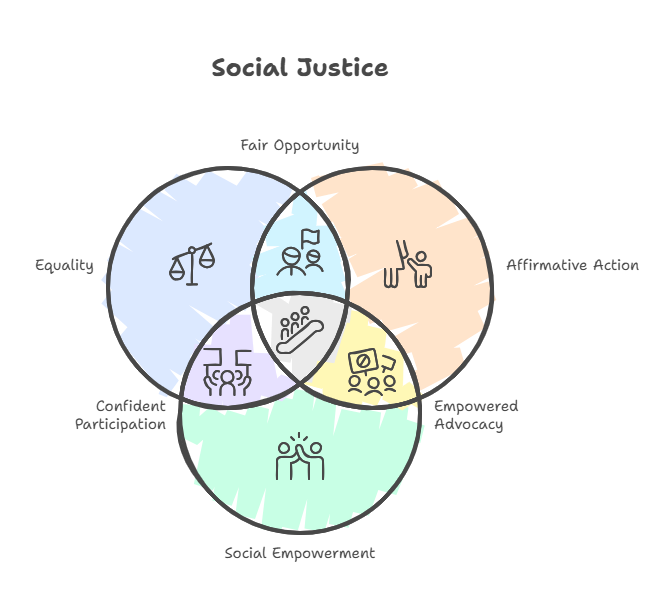- Filter By :
- Polity & Governance
- International Relations
- Social Justice
-
Q. "The concept of social justice in India is intertwined with the principles of equality, affirmative action, and social empowerment." Discuss how the Constitution of India addresses social justice, particularly for marginalized communities. (250 words)
15 Jul, 2025 GS Paper 2 Social JusticeApproach:
- Introduce the answer by briefing about ideals of Social Justice in Indian Constitution and how it is intertwined with the principles of equality, affirmative action, and social empowerment
- Give arguments to Principles of Equality in the Constitution Affirmative Action and Special Provisions for Marginalized Communities and Social Empowerment
- Conclude with a quote.
Introduction
Social justice aims at creating a fair and equitable society by removing historical disadvantages, ensuring equal opportunities, and empowering the marginalized. The Preamble as the identity card of the Constitution sets the tone by committing the Indian State to justice—social, economic, and political.
- It is reinforced through Fundamental Rights and Directive Principles of State Policy, it is inseparable from the principles of equality, affirmative action, and social empowerment.
Body:
Principles of Equality in the Constitution
- Equality Before Law (Article 14): Article 14 guarantees that all citizens are equal before the law and entitled to equal protection of the laws.
- This provision ensures that no individual or group is discriminated against, establishing the foundation of equality in Indian democracy.
- Prohibition of Discrimination (Article 15): Article 15 prohibits discrimination on the grounds of religion, race, caste, sex, or place of birth.
- It ensures that marginalized communities cannot be discriminated against in public places, educational institutions, or employment.
- Equality of Opportunity (Article 16): Article 16 ensures equality of opportunity in matters of public employment.
- It specifically prohibits discrimination in employment on the grounds of religion, race, caste, sex, or place of birth, reinforcing the idea that public service should be accessible to all citizens.
- These provisions form the bedrock of social justice by guaranteeing equality and non-discrimination, particularly for marginalized and vulnerable sections of society.
Affirmative Action and Special Provisions for Marginalized Communities:
- Reservation of Seats in Legislatures (Article 81 & 170): The Constitution provides for reservations in the Lok Sabha and Rajya Sabha for Scheduled Castes (SCs) and Scheduled Tribes (STs).
- Nari Shakti Vandan Adhiniyam reserves one-third of all seats for women in the Lok Sabha and the state legislative assemblies.
- Reservation in Educational Institutions (Article 15(4), 15(5)): Article 15(4) empowers the state to make special provisions for the advancement of socially and educationally backward classes of citizens.
- Similarly, Article 15(5) specifically allows reservations for OBCs, SCs, and STs in educational institutions, aiming to provide them access to quality education, thereby breaking the cycle of poverty and backwardness.
- Reservation in Employment (Article 16(4)): To ensure adequate representation and participation in public services, Article 16(4) allows for reservations for backward classes, SCs, and STs in public employment.
- This helps rectify the historical underrepresentation of these communities in government jobs, which are crucial for social mobility and empowerment.
- Special Provisions for STs (Article 46): Article 46 promotes the welfare of Scheduled Tribes by directing the state to protect and advocate for their educational and economic interests.
- It emphasizes protecting the interests of these communities against exploitation, thereby empowering them socially and economically.
Social Empowerment:
- Right to Dignified Life: Rights such as the Right to Education (Article 21A) and Right to Life and Personal Liberty (Article 21) are particularly significant. These rights protect individuals from exploitation and discrimination, providing avenues for empowerment.
- Protection from Exploitation (Article 23 & 24): Article 23 prohibits human trafficking and forced labor, which disproportionately affect marginalized communities. Similarly, Article 24 prohibits the employment of children under the age of 14 in hazardous occupations, directly addressing exploitation within vulnerable sections of society.
- India as a Welfare State (DPSPs): While DPSPs are not enforceable by courts, they reflect the aspirations of the state to promote social justice.
- Article 38 urges the state to promote the welfare of the people by securing a social order based on justice, and Article 39A calls for equal justice and free legal aid, ensuring that justice is not denied to any citizen due to economic or social barriers.
Empowering Marginalized Communities through Specific Laws and Programs
The Constitution also facilitates the empowerment of marginalized communities through specific laws and programs aimed at addressing the historical and systemic injustices they face.
- Scheduled Castes and Scheduled Tribes (Prevention of Atrocities) Act, 1989 seeks to prevent the exploitation and discrimination of SCs and STs by providing legal remedies and punishment for crimes such as untouchability and exploitation.
- This reinforces the Constitution’s vision of dignity and equality for marginalized communities.
- The Constitution establishes bodies like the National Commission for Scheduled Castes (NCSC) and the National Commission for Backward Classes (NCBC) to monitor the implementation of policies and safeguard the interests of these communities.
- The Panchayats (Extension to Scheduled Areas) Act, 1996 (PESA) and the Forest Rights Act, 2006 empower tribal communities by recognizing their rights over land, resources, and governance structures.
- These legal provisions support the inclusion and empowerment of tribal people in local governance and the protection of their resources.
Conclusion:
The Constitution of India treats social justice not as an abstract ideal, but as a guiding principle for inclusive nation-building. As Dr. B.R. Ambedkar rightly said, “Justice is the soul of the Constitution.” To truly realise this soul, the State must ensure that justice is not only promised but delivered where it is needed most.
To get PDF version, Please click on "Print PDF" button.
Print PDF





